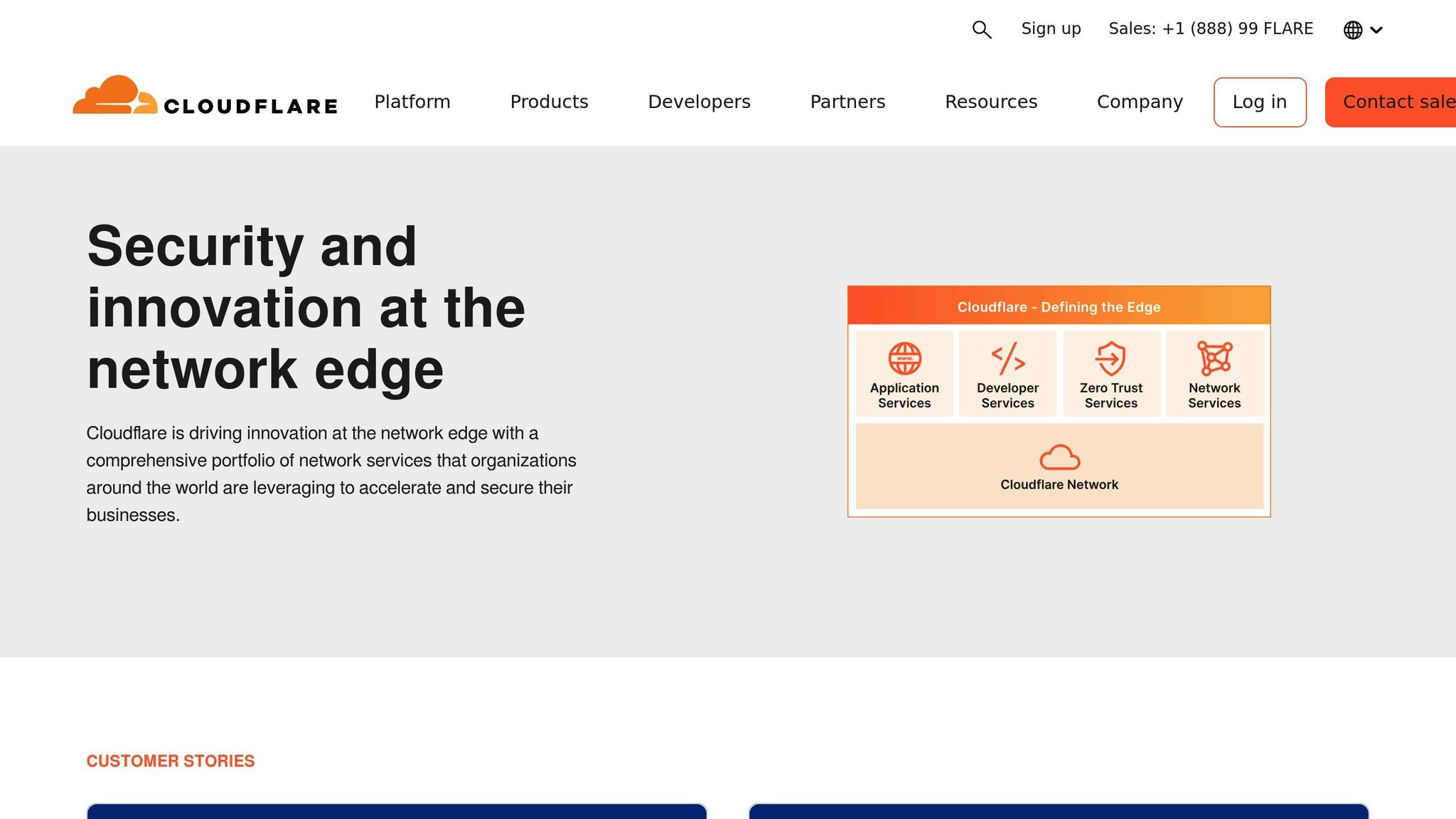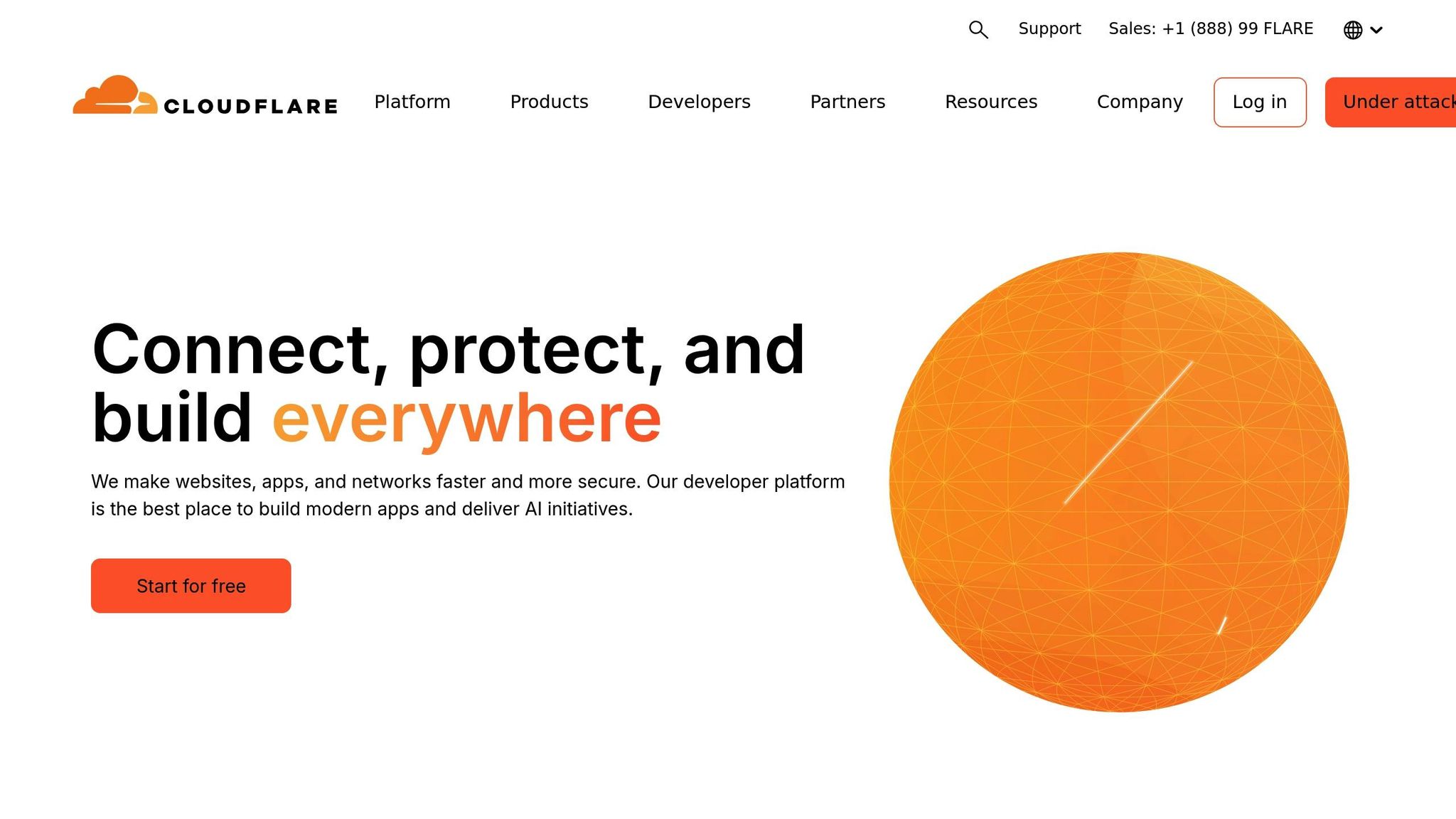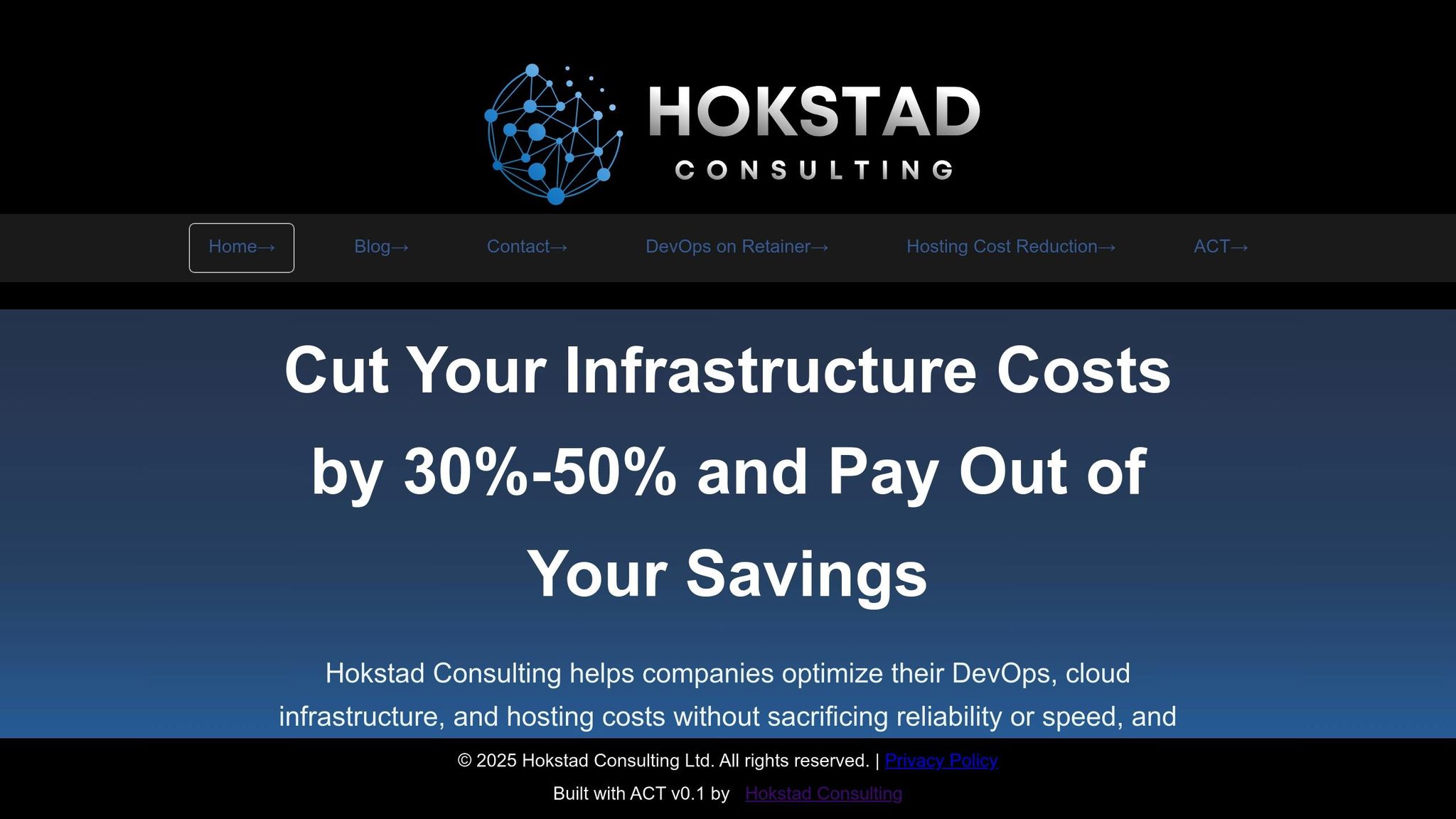Slow-loading websites lose customers and revenue. In the UK, 53% of mobile users abandon sites that take over 3 seconds to load, and a 2-second delay can cost businesses 4.3% of revenue per visitor. For a £1 million e-commerce business, that’s £43,000 annually.
Cloudflare Edge improves speed by delivering content from the closest data centre. With over 330 locations globally, including the UK, it reduces latency, boosts load times, and enhances user experience. Key metrics like Time to First Byte (TTFB), cache hit ratios, and error rates help businesses measure and improve performance.
Key Takeaways:
- Faster Load Times: Cloudflare delivers content to 95% of users within 50ms.
- Cost Savings: Hosting costs can drop by 30–50% with optimised caching.
- Sustainability: Cloudflare uses 100% renewable energy, cutting CO₂ emissions.
- High Traffic Resilience: Handles up to 142 TB/sec throughput and mitigates DDoS attacks.
By leveraging tools like Cloudflare Workers, UK businesses can customise caching, improve response times, and meet compliance standards. Faster sites mean happier users, fewer bounces, and higher conversions.
Is edge
computing really faster?
Cloudflare Edge Network: How It Works for UK Businesses

Cloudflare's edge network operates by using a vast network of data centres spread globally to deliver content from the location closest to the user. This eliminates the need to route all traffic through a single server, cutting down on travel time. For UK businesses, this translates to faster website load times and a smoother user experience.
With over 330 data centres worldwide, including multiple sites across the UK and Europe, Cloudflare ensures proximity to users[2]. For instance, a user in Manchester would receive content from a local server rather than one thousands of miles away. This setup enables Cloudflare to deliver content to 95% of users within approximately 50 milliseconds[2]. These efficiencies can improve overall performance by up to 35%, directly benefiting user engagement and boosting conversion rates for UK businesses[2]. These performance improvements are foundational to the metrics explored later in this discussion.
Anycast Network and UK Data Centre Locations
At the heart of Cloudflare's performance gains is its Anycast network architecture. Unlike traditional networks that route traffic to a specific server, Anycast allows multiple data centres to share the same IP address. When a user makes a request, the system automatically directs it to the closest data centre with available capacity[3]. This approach not only reduces latency but also supports an impressive throughput of up to 142 TB/sec[4]. Additionally, the network integrates with over 13,000 major service providers, cloud platforms, and enterprise networks, ensuring optimised traffic routes and minimal delays[1].
This distributed model also enhances resilience, particularly during traffic spikes or DDoS attacks.
For example, a major retailer using Cloudflare successfully shifted over 95% of its traffic to the network, resulting in faster page loads and more efficient management of bandwidth surges[2].
Renewable Energy and Environmental Impact
Cloudflare doesn’t just focus on speed and reliability - it also prioritises sustainability. The company is committed to powering its entire network with 100% renewable energy[5]. By 2025, Cloudflare aims to eliminate all greenhouse gases generated since the network's inception in 2010[5]. To achieve this, the company purchases Renewable Energy Credits (RECs), I-RECs, and REGOs. In 2020, these certificates were sourced from various countries, including the UK, ensuring that local data centre operations benefit from green energy[5].
For UK businesses, adopting Cloudflare can lead to significant reductions in network-related carbon emissions - up to 96% for smaller companies and 78% for larger enterprises[6]. This is particularly relevant given that Internet usage accounts for 3.7% of global CO₂ emissions[6].
Matthew Prince, co-founder and CEO of Cloudflare, underlines the company’s dedication:
We want to give the Internet a clean slate to help build toward a future where it's easy for anyone to create, build, and run their applications on green energy while remaining secure, fast, and reliable.[7]
Cloudflare also offers UK businesses the option to use Green Compute on Cloudflare Workers. This feature allows workloads to be routed to facilities powered by renewable energy, enabling companies to meet performance objectives while aligning with environmental goals[5].
Performance Metrics: What to Measure and Why
For UK businesses looking to optimise Cloudflare Edge performance, understanding which metrics to track is crucial. These metrics provide clear insights into how quickly your applications respond to users and highlight areas needing improvement. Key performance indicators (KPIs) fall into several categories, each offering a unique perspective on your application's performance.
Download speed, upload speed, latency, jitter, and packet loss form the backbone of network performance measurement [8]. However, when it comes to web applications, additional metrics like Time to First Byte (TTFB) and cache performance play a significant role. Let’s dive into the core timing metrics that directly influence user experience.
Latency, Throughput, and Time to First Byte (TTFB)
Latency measures how long it takes for data to travel from your server to the user and back. For example, a packet travelling across the globe can experience a latency of at least 250 milliseconds [11]. For UK businesses catering to local customers, reducing physical distance between servers and users is key to minimising latency.
Time to First Byte (TTFB) captures the time between a user's request and the moment the first byte of data reaches their browser. This metric is vital because it reflects an entire round trip of latency [12]. A good TTFB is under 800 milliseconds [10]. A higher TTFB often signals server or network issues that could slow down your site.
While a good TTFB doesn't necessarily mean you will have a fast website, a bad TTFB almost certainly guarantees a slow one.- Harry Roberts, Consultant Web Performance Engineer, CSS Wizardry [12]
Throughput measures the actual rate of data transfer, as opposed to bandwidth, which refers to the network's maximum capacity [11]. Low throughput often points to network congestion or inefficient data handling, both of which can degrade the user experience for UK audiences.
Factors like processing time, database queries, API calls, and hosting quality can all affect TTFB [12]. While users may not directly notice TTFB, it underpins all other loading metrics that they do experience [13].
Cache Hit Ratio and Error Rates
Cache hit ratio tracks how effectively your cache serves content without needing to fetch it from the origin server [18]. This metric directly influences performance and reduces server load. For static-content-heavy websites, a cache hit ratio of 95–99% is typical [15], while sites with dynamic content often achieve lower ratios [16].
Error rates measure the percentage of visitors encountering errors when accessing your application [17]. High error rates not only frustrate users but also signal critical infrastructure issues. Websites that take over four seconds to load risk losing user trust [17], while those delivering content in 800 milliseconds feel noticeably faster than those taking 1,500 milliseconds [17].
To improve cache hit ratios, implement proper cache control directives and fine-tune Time-To-Live (TTL) settings [16]. For error rate reduction, regularly review error logs to identify recurring problems. If errors spike alongside increased traffic, it could indicate bot activity [17].
Testing Methods and Data Collection
Tracking server-side metrics is only part of the solution. Reliable testing methods ensure consistent performance validation. Running multiple speed tests provides more accurate results [8] than single tests, which can be affected by temporary network conditions or server loads.
First Contentful Paint (FCP) is a user-focused metric that measures perceived load speed [10]. An FCP under 1.8 seconds is considered good [10], offering a more user-centric complement to technical metrics like TTFB.
Advanced tools like Cloudflare’s Speed Test provide detailed performance data, including packet loss, load latency, and data volume [8]. This level of detail helps UK businesses pinpoint specific bottlenecks in their application delivery.
To get a full picture, combine synthetic tests with real user monitoring (RUM). This approach captures both controlled data and real-world performance from users across different UK regions and network conditions. Tools such as Ping, Curl, Browser Developer Tools, and Web Vitals are excellent for measuring latency [14], while throughput can be tracked with specialised monitoring solutions [11].
Regular monitoring ensures UK users enjoy a fast and reliable experience, which is essential for modern web applications.
Benchmark Results: Cloudflare Edge Performance Data

Real-world metrics highlight how UK businesses benefit from adopting Cloudflare Edge for content delivery. These benchmarks showcase improvements in latency, traffic handling, and overall speed, offering a clearer picture of its performance advantages.
Latency Improvements and Page Load Speed
Cloudflare’s global network architecture is designed to significantly enhance performance. With its Anycast network spanning over 310 cities across 120 countries[20], the platform achieves noticeable reductions in Time to First Byte (TTFB). For example, CDN Planet’s October 2023 trial of Speculation Rules demonstrated a 300-millisecond reduction in TTFB for 20% of eligible pageviews[24], bringing many websites within the recommended target of under 300 milliseconds[25].
For UK businesses, these latency improvements translate into smoother user experiences. Websites grappling with TTFB values above 400 milliseconds can benefit from SSD-based edge caching, which outperforms traditional hard drives[9]. Moreover, edge delivery not only boosts cache hit ratios but also reduces the need for origin server requests, cutting bandwidth demands and lowering egress costs[23]. Many websites with high volumes of static content now achieve cache hit ratios between 95% and 99%[15].
High Traffic Performance
Cloudflare Edge is built to handle extreme traffic loads with ease, processing over 50 million HTTP(S) and 70 million DNS requests per second[20]. Its resilience was tested between August and October 2023, when it mitigated attacks exploiting the HTTP/2 Rapid Reset vulnerability. During this period, attack rates averaged 30 million requests per second, with peaks exceeding 100 million requests per second in nearly 90% of cases. The largest attack reached a staggering 201 million requests per second[20].
Despite these challenges, Cloudflare ensured uninterrupted service for legitimate users. Its Anycast architecture and software-driven security measures maintain high reliability across 270+ data centres, supporting throughput rates of up to 142 terabytes per second[21]. This robust design allows multiple nodes to go offline without affecting service quality, ensuring UK customers experience minimal disruptions - even under intense conditions.
Cloudflare increases web application performance and availability by bringing content closer to your users, caching static content on its network, optimising image files, compressing dynamic content, routing requests to the least congested path, and much more. Deliver fast web experiences to users on the world's most-connected network, offering effortless scale.– Integrity360 Limited [21]
Before and After Performance Comparison
Data from September 2023 highlights the typical performance benefits for UK businesses after adopting Cloudflare Edge. Improvements were particularly evident in TTFB metrics for both desktop and mobile platforms, alongside notable increases in cache hit ratios. These enhancements are a result of Cloudflare’s focus on performance optimisation, where a high cache hit ratio not only improves user satisfaction but also reduces operational costs[23]. Additionally, its advanced DDoS mitigation and Web Application Firewall (WAF) Managed Rules protect applications from disruptive attacks[20].
For enterprise-level customers in the UK, Cloudflare provides additional reliability by rerouting traffic during high-load events[21]. While reducing TTFB is a key achievement, the combined effects of better caching, lower latency, and smarter traffic routing lead to significant improvements in overall application performance[22].
To monitor these gains, UK businesses can use Cloudflare’s built-in alerting tools. Features like HTTP Traffic Alerts detect spikes in 5xx error responses, Advanced Error Rate alerts monitor origin or edge status codes, and Traffic Anomalies alerts identify unusual traffic patterns[19].
Need help optimizing your cloud costs?
Get expert advice on how to reduce your cloud expenses without sacrificing performance.
Advanced Features: Workers and AI for Better Performance
Cloudflare builds on its edge performance capabilities with advanced tools like Workers and AI-powered features, offering UK businesses the ability to optimise traffic, security, and user experiences directly at the edge. These innovations redefine how applications manage performance and handle user interactions.
Smart Caching and Traffic Routing
Cloudflare Workers allow developers to deploy serverless JavaScript code across Cloudflare's global network of over 250 data centres[27]. This enables businesses to customise how requests and responses are processed at the edge, creating solutions tailored to UK and EU traffic patterns.
By using Workers, businesses can set up custom caching rules that reduce server strain and improve response times. For UK companies, this means faster load times during peak trading hours, ensuring a smoother experience for users when demand is at its highest[27].
Taking this a step further, Workers AI integrates machine learning directly into the edge network[32]. These features analyse traffic patterns and pre-cache content based on regional preferences, helping UK businesses prepare for spikes in demand before they happen.
By bridging the front-end and back-end with a third place to develop code, we're excited Cloudflare Workers will empower a new class of applications that were previously impossible. I can't wait to see what developers build.- Matthew Prince, co-founder and CEO of Cloudflare[26]
Industries like e-commerce and online gaming have already seen up to a 50% improvement in response times during high-traffic periods, thanks to dynamic routing and optimised caching provided by Workers AI[32]. This is especially beneficial for UK retailers managing seasonal sales or gaming platforms catering to latency-sensitive audiences.
Workers also make real-time content personalisation possible without requiring separate site versions. Businesses can dynamically adjust HTML content based on user demographics, location within the UK, or browsing behaviour, delivering personalised experiences that enhance engagement and boost conversion rates[27].
Security Features and UK Compliance
In addition to performance improvements, these tools strengthen security and support compliance with UK regulations. Cloudflare's advanced features align with GDPR and other data protection standards, ensuring sensitive data stays within the required geographical boundaries while maintaining optimal speed.
The AI Gateway adds another layer of security with intelligent rate limiting and monitoring for AI deployments[31]. This is especially relevant for UK businesses integrating AI into their applications, as it offers edge caching with a 25MB request size limit and a one-month cache TTL in the free tier[30].
Cloudflare Workers saves us a great deal of time. Managing bot traffic without Workers would consume valuable development and server resources that are better spent elsewhere.- John Thompson, Senior System Administrator at MaxMind[26]
Workers also enable custom analytics and tracking at the edge, allowing businesses to gather insights on user interactions while adhering to UK privacy laws[27].
Cost and Performance Benefits for UK Companies
Cloudflare's Workers aren't just technically advanced - they're also cost-efficient. Starting at just 50p per million tasks[26], the pricing model eliminates the need for dedicated servers, making it a budget-friendly option for executing custom logic.
Workers rely on isolates powered by the V8 engine for lightweight, low-overhead execution[28]. This approach reduces memory usage and ensures instant execution, which is especially valuable for UK businesses looking to manage costs while maintaining high performance.
For companies with variable traffic patterns, Workers offer the flexibility to scale automatically based on demand. Instead of provisioning servers for peak loads, businesses pay only for the resources they use during busy periods.
Moving away from VCL and adopting Cloudflare Workers will allow us to do some creative routing that will let us deliver JavaScript to npm's millions of users even faster than we do now. We will be building our next generation of services on Cloudflare's platform and we get to do it in JavaScript!- CJ Silverio, CTO of npm, Inc.[26]
Cloudflare also provides analytics tools to monitor performance and identify opportunities for improvement[27]. Features like Smart Edge Revalidation automatically adjust caching behaviour when origin servers lack standard headers, ensuring consistent performance without manual adjustments[29].
These capabilities enable UK businesses to compete effectively in global markets, all while staying agile enough to adapt to changing demands or traffic patterns.
Hokstad Consulting: Cloudflare Optimisation for UK Businesses

Hokstad Consulting specialises in Cloudflare Edge optimisation, designed to enhance application performance and cut hosting expenses for organisations across the UK. By combining technical know-how with a deep understanding of UK-specific compliance and infrastructure challenges, they deliver tailored solutions. Below, we explore their strategies for performance testing, cost savings, and ongoing support, all focused on the unique needs of UK businesses.
Performance Testing and Optimisation Services
Hokstad Consulting kicks off every project by benchmarking performance, measuring key metrics like latency, time to first byte (TTFB), cache hit ratios, and throughput across UK-based data centres. This initial step pinpoints bottlenecks and establishes a baseline for improvement.
They utilise custom monitoring tools from multiple UK cities, including London, Manchester, and Edinburgh, to ensure consistent performance nationwide. This detailed testing identifies where Cloudflare’s edge network can have the greatest impact.
To keep performance improvements intact as applications grow, Hokstad integrates automated CI/CD pipelines for deploying and managing Cloudflare Workers. These pipelines streamline updates and ensure ongoing efficiency.
In addition, they create bespoke Workers solutions tailored to the needs of UK industries. For example, they can design smart caching systems to handle seasonal surges in e-commerce or develop routing logic for financial services applications. Their cloud migration services are designed to ensure zero downtime, enabling businesses to transition smoothly to Cloudflare-optimised architectures while benefiting from immediate performance enhancements and scalability for the future.
Cost Reduction and Performance Gains
Hokstad Consulting operates on a No Savings, No Fee
model, a testament to their confidence in delivering measurable outcomes. Their services typically reduce hosting costs by 30–50% while simultaneously improving performance.
Their cost-saving strategies go beyond simple service consolidation. They implement advanced caching techniques, offloading mechanisms, and hybrid cloud architectures to maximise the value of Cloudflare for UK organisations. For businesses with fluctuating traffic, these methods can significantly lower costs during peak periods.
Performance optimisation also contributes to cost efficiency. For instance, Fossil Group saved over £800,000 annually while achieving 20% faster page load times[33].
Cloudflare's reduced cost and wide range of integrated services made committing to the new solution a slam dunk.– Kevin Fabec, Security Director, Fossil Group[33]
Similarly, LendingTree experienced up to a 70% improvement in page load times using Cloudflare's tools[34]. For industries like e-commerce and financial services, such gains often lead to higher conversion rates and better customer satisfaction.
Hokstad’s cloud cost audits provide detailed insights into spending patterns, identifying specific areas for optimisation. This ensures businesses not only know what changes to implement but also understand the long-term benefits those changes will bring.
Ongoing Support and Monitoring
Hokstad Consulting doesn’t stop at delivering initial results - they provide continuous monitoring and adaptable support to ensure Cloudflare optimisations keep pace with evolving business needs.
Their performance monitoring includes regular security audits, with a focus on UK regulations like GDPR and financial services compliance. Early detection of performance issues or security vulnerabilities allows for proactive solutions, minimising disruptions.
Beyond basic uptime checks, their monitoring covers cache performance, Worker execution times, and traffic trends. This comprehensive approach helps spot improvement opportunities before they affect end users. Regular reviews of performance metrics ensure consistent refinements, keeping systems running at peak efficiency.
For businesses requiring more comprehensive solutions, Hokstad offers managed hosting services. These combine Cloudflare optimisation with broader cloud infrastructure management, providing a single point of contact for all hosting and performance needs.
They also assist businesses in leveraging Cloudflare’s advanced features, such as intelligent caching, automated traffic routing, and analytics tools. These features offer deeper insights into application performance and user behaviour.
For urgent issues, Hokstad’s rapid response team is ready to diagnose and resolve problems quickly, minimising downtime and operational impact. Whether it’s a sudden performance dip or a security concern, their expertise ensures swift and effective resolutions.
Conclusion: Improving UK Application Performance with Cloudflare Edge
Benchmarking data highlights how Cloudflare Edge significantly improves application performance in the UK. Handling over 10% of global internet traffic and powering more than a quarter of all websites worldwide, Cloudflare's network consistently delivers reliable results at scale [35].
For UK organisations, the platform offers a noticeable boost in speed, with static content cached and delivered within 50 milliseconds for 95% of users [38]. This is further enhanced by Cloudflare's data centres located in the UK and across the EEA, ensuring compliance with GDPR requirements [36][37].
Case studies reinforce these benefits. In 2025, Picsart reported impressive results, achieving 2–3 times faster image load times while cutting their monthly bandwidth usage by over 50%. The Picsart team shared:
With Cloudflare, the load time of our images improved by 2-3x. And on top of that, we're saving over 50% on our monthly bandwidth usage.[38]
Cloudflare’s Anycast architecture also stands out, supporting up to 142 TB/sec throughput, which ensures the scalability and reliability needed by growing UK businesses [37]. This combination of speed, security, and scalability provides a solid foundation for expert optimisation.
Companies like Hokstad Consulting help UK organisations maximise these benefits. Through their cloud cost engineering expertise, they enable businesses to reduce hosting costs by 30–50% using a No Savings, No Fee
approach. Their focus on compliance and cost efficiency ensures organisations can fully leverage Cloudflare Edge's capabilities.
With its proven performance advantages, robust security measures, GDPR compliance, and expert implementation support, Cloudflare Edge offers a strategic solution for UK businesses seeking to enhance application speed and user experience. By optimising their use of the platform, organisations can achieve these performance improvements while keeping costs under control and meeting regulatory standards.
FAQs
How does Cloudflare Edge boost website performance for businesses in the UK compared to traditional hosting?
Cloudflare Edge boosts website performance for UK businesses by cutting down latency through its extensive global edge network. By caching content closer to users and fine-tuning traffic routes, it ensures quicker load times and a smoother browsing experience. This is especially important for applications that demand fast response times.
Traditional hosting relies on centralised servers, which can often result in slower speeds and increased latency. In contrast, Cloudflare Edge uses its distributed network to deliver content directly to users. This not only improves speed and reliability but also strengthens security, making it a smart solution for businesses looking to provide a seamless online experience.
What key metrics should UK businesses track to evaluate how Cloudflare Edge improves website performance?
To understand how Cloudflare Edge boosts website performance, businesses in the UK should pay attention to several key metrics:
- Latency: This measures how long it takes for a user's request to travel to the server and back, directly affecting site responsiveness.
- Download and upload speeds: These indicate how swiftly data is transferred, which is crucial for smooth browsing and file exchanges.
- Response times: This reflects how quickly the server processes and replies to user requests, influencing overall performance.
- Application uptime: A critical measure to ensure your website remains accessible and reliable for users at all times.
Tracking these metrics offers a clear picture of network performance and user experience, enabling businesses to fine-tune their online operations for better results.
How does Cloudflare's use of renewable energy help UK businesses reduce their carbon footprint and support sustainability efforts?
Cloudflare's dedication to using 100% renewable energy offers a big advantage to UK businesses by cutting down the carbon footprint of their digital activities. By reducing greenhouse gas emissions tied to internet infrastructure, Cloudflare helps businesses meet their environmental targets while staying aligned with the UK's climate commitments.
On top of that, Cloudflare's initiatives to offset and remove past carbon emissions add another layer of sustainability. This forward-thinking approach not only strengthens the environmental reputation of UK businesses but also contributes to building a more eco-friendly internet for the years ahead.
